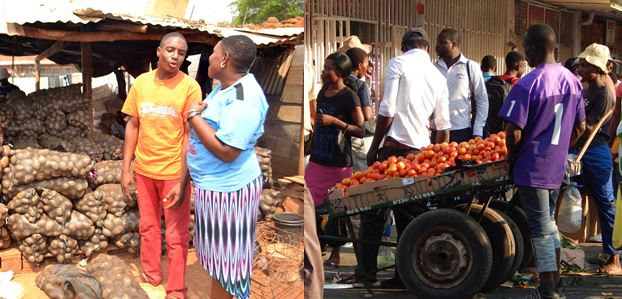By Charles Dhewa
No matter how many times this question is answered, it continues to be asked again and again. One of the reasons is that the answer may be correct but unbelievable. As in all other markets, rules of supply and demand influence pricing of agricultural commodities in open markets that are powerful ecosystems in developing countries.
In fact the major determinant of price is supply with demand only responding to supply. In big urban food markets like Mbare in Harare, when the market opens at 5am in the morning, it takes a few minutes for sellers and buyers to see that today there are more tomatoes than yesterday.The farmer or trader whose supply coincides with a shortage starts setting the calling price based on the previous day’s price.
Another sign of a shortage is the concentration of many buyers around one consignment or heap of tomatoes or potato and this also influencing the price. Some of the buyers pull away from the crowd and approach the seller independently, offering prices. Through a silent auctioning mechanism by buyers and sellers, the day’s prices are quickly agreed upon and trading gets underway.
From the calling price to the actual final price
In all open mass markets across Africa, there is a distinction between the calling price and the final price. The calling price is what the farmer, trader or seller expects to get while the final price is what the commodity finally fetches. In the marketing process buyers resort to several negotiation dynamics like referring to yesterday’s price trends. They can begin negotiations by saying, “yesterday’s prices were lower for the same quality, why are you demanding a higher price today? Your quality is also lower than yesterday and your crates are not full.”
There is also an element of ganging up among buyers. For instance if a new buyer comes along and finds other buyers standing alongside the commodity but not buying, the new buyer gangs up with those standing in order to push the final price down. This ganging up ends up re-setting the price. Another name for this practice is demand response to supply. While some buyers just stand near the commodity, others buy a few commodities in protest. In addition to complaining about many things related to the commodity, some buyers use comparisons. They can say, “This same quality of commodity is going for a lower price in the other market and supermarkets.” Some of the buyers go to an extent of verbally abusing the commodity owner or seller. “You are better off taking my offers and going home early than wait for prices to rise when your commodities at the farm have no one attending them.”
Farmers and sellers use the same technique
On the flip side, farmers and sellers also use the same tactics when they find the market in short supply. The farmer or seller observes the way buyers stampede for commodities and tap into such levels of desperation by buyers to pretend that s/he does not want to sell. As a result buyers bid and increase their offers. Ultimately this is also how actual prices are determined and set. This process can be complete within a minute when a commodity is in short supply but can stretch for 30 minutes to an hour if there is a glut. Loaders, off-loaders and those who carry commodities to waiting trucks also respond to the price of the commodity such that if the price increases they also increase their costs correspondingly.
Additional tactics used by buyers on farmers
Even if they may have struck relationships with farmers, buyers keep a bag of tricks. They send part payment and packaging to the farmer so that the farmer starts harvesting butternuts or other perishables. The buyer makes a point of arriving to collect the consignment with a truck when the farmer is packaging or has already finished packaging. At that point the buyer opens the conversation by undermining the quality of the commodity (“Aaah why is this commodity different from the last one? You have to lower the price for me this time.”) After a few uncomfortable exchanges, the buyer ends up getting the commodity at a price he determines. He knows that the farmer cannot start looking for another new buyer when the perishable commodity is already harvested and packaged.
Need for regulations and policy interventions
Dynamics and processes mentioned above show the extent to which linking farmers to the market is not enough unless the entire processes and hidden behavioral economics tricks are fully understood. Ideally farmers should know distances from where they are farming to the market and the cost of moving commodities to the market. They should also strive to be aware of the margin earned by traders from each commodity and consignment. A pricing index and farmers’ diary comprising information related to distances to the nearest markets as well as all critical cost elements should be developed especially for smallholders who often struggle to find usable market information beyond just price.
Circumstances under which price information is critical for farmers include:
- When a buyer shows up on-farm and the farmer needs to make a decision to sell at the right price.
- When the farmer has not done his/her costing and wants to use the market price as a guide. This is very common among many farmers.
- When the farmer wants to sell locally and has to compare with prices elsewhere.
- When the farmer wants to conduct barter exchange between different commodities. The farmer has to know the monetary value of the two different commodities being bartered.
A major challenge in most developing countries is that it is difficult to regulate the production and supply of rain-fed agricultural commodities. Regulating production and supply is easy with irrigated production. You cannot tell farmers to grow fewer groundnuts or tubers which may be the only ideal commodities in particular areas and farming seasons. One can regulate the production of cabbages, tomatoes and potatoes whose production can be controlled to some extent in response to the market. It does not make sense for government to set the same prices for commodities whose yields can be very low in some areas due to rainfall patterns, soil types and other factors.






